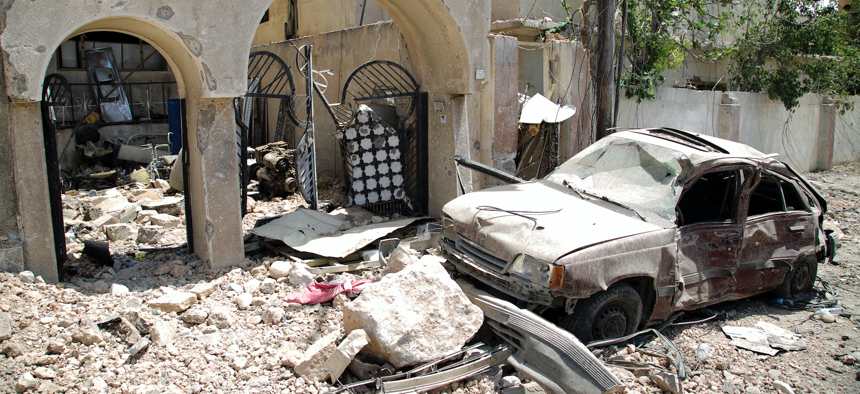
In west Mosul, human rights groups say that Iraqi and coalition forces are using inherently inaccurate and indiscriminate heavy weaponry to dislodge Islamic State militants from the city, putting the tens of thousands of civilians still in the city. Balint Szlanko/AP
Don’t Loosen the Rules on Civilian Casualties During Drone Strikes
The Trump team may eliminate the “near certainty” clause, which would do far more damage to US counterterrorism than retaining it.
Since Donald Trump took office, the number of civilian casualties caused by U.S. drone strikes has skyrocketed. Now, a dozen human rights groups are calling on the United States to strengthen and preserve its commitment to avoid harming civilians outside of war zones during counterterrorism strikes. As more countries acquire — and use — armed drones, it is vital for the U.S. to say that there is no such thing as an “acceptable” civilian casualty caused by lethal strikes outside of conflict. A failure to do so risks creating a world where not only is the U.S. no longer one of the few countries using these drones, but more countries will begin to use them in a way the U.S. cannot control.
Fifteen years after 9/11, the United States’ use of drone strikes to kill suspected terrorists is the normal cost of doing business for most Americans. But the decision to use lethal force as the primary tactic to fight terrorism outside of declared war zones, and constructing a legal rationale for doing so, has broken with decades of legal precedence. The standing rules governing international order, not to mention international human rights law, have long held that governments should work together to arrest and prosecute criminals on the basis of legitimate legal grounds rather than killing them outright, lest governments deal with any security issue outside of their borders by killing. In fact, when the Libyan government assassinated political opponents in the United States in 1981, the U.S. investigated and prosecuted them to the fullest extent of the law. The killing of IRA suspects in Gibraltar in 1988 by UK special forces led to a public inquiry and significant public backlash. Similarly, more recent assassinations and attempted assassinations of political opponents by the Russian and North Korean governments have been met with intense international scrutiny.
Faced with the possibility of receiving intelligence on terrorists planning catastrophic attacks, Presidents George W. Bush and Barack Obama both decided the benefits of drone technology were too alluring to resist, even at a tremendous cost to the sanctity of due process. Despite this dangerous calculation, both administrations also recognized that even if circumstances required the use of lethal force outside of war zones, innocent civilians had to be spared. They knew, as Defense Secretary Mattis and National Security Council Advisor McMaster certainly know, that it is illegal to knowingly kill innocent civilians if you are not fighting a war and in the absence of an imminent threat to civilian life.
In 2013, President Obama, who drastically increased the number of drone strikes during his tenure, delivered a speech in which he outlined the contours of new Presidential Policy Guidance, or PPG, making this principle abundantly clear. Henceforth, the decision to target and kill people outside “areas of active hostilities” would require a “near certainty” of no civilian casualties, and lethal force would only be used when capture was not feasible. In essence, the use of force in these limited circumstances would more closely approximate a law enforcement, rather than wartime, paradigm. The language in the PPG left many in the legal, civil liberties, and human rights community dissatisfied, and for good reason. The policy enabled preemptive lethal force without due process, and introduced the paradoxical concept of “continuous” yet “imminent” threat. But if nothing else, the PPG tried to preserve an important presidential commitment to sparing innocent lives.
Reports now suggest that the Trump administration wants to change, and maybe even rescind, President Obama’s policy guidance. Rather than addressing outstanding concerns and gaps in existing policy, the Trump team may seek to eliminate the “near certainty” clause out of concern that the rule inhibits counterterrorism efforts—a claim there is no evidence to support. This is beyond troubling, especially as Airwars, an independent watchdog group, recently reported that coalition airstrikes have killed nearly 4,000 civilians, a stark contrast to the 484 United States Central Command admits to killing.
The purpose and value of the “near certainty” standard centers around, but also extends well beyond, concern for human life. It helps to preserve a basic respect for the rule of law that the United States helped create and defend for five decades. This— albeit very limited— constraint on military action enables the United States to more credibly employ and defend the use of lethal force in places where civilian casualties have wrought strategic consequences. Even small numbers of unintentional civilian deaths or injuries can backfire on American interests, something dozens of national security experts from across the political spectrum cautioned the Trump administration in March.
Americans must demand the Trump Administration keep, or strengthen, these protections for civilians. As more countries and non-state armed groups around the world acquire armed drones, it is critical that the United States seek to set an example for other nations and demonstrate that its use of force practices adhere to its obligations under international law. U.S. interests are best served by showing that we, too, can play by the rules.



